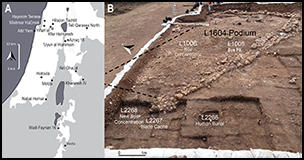Crossref Citations
This article has been cited by the following publications. This list is generated based on data provided by
Crossref.
Meier, Jacqueline S.
Goring-Morris, A. Nigel
and
Munro, Natalie D.
2017.
Depositional histories of faunal remains from the Neolithic cultic site of Kfar HaHoresh, Israel.
Journal of Anthropological Archaeology,
Vol. 48,
Issue. ,
p.
233.
Munro, Natalie D.
and
Grosman, Leore
2018.
The Social Archaeology of the Levant.
p.
47.
Reshef, Hagar
Anton, Marie
Bocquentin, Fanny
Vardi, Jacob
Khalaily, Hamoudi
Davis, Lauren
Bar-Oz, Guy
and
Marom, Nimrod
2019.
Tails of animism: a joint burial of humans and foxes in Pre-Pottery Neolithic Motza, Israel.
Antiquity,
Vol. 93,
Issue. 371,
Peters, Joris
Schmidt, Klaus
Dietrich, Laura
Dietrich, Oliver
Pöllath, Nadja
Kinzel, Moritz
and
Clare, Lee
2019.
Encyclopedia of Global Archaeology.
p.
1.
Robins, Andrew
2019.
The Alpha Hypothesis: Did Lateralized Cattle–Human Interactions Change the Script for Western Culture?.
Animals,
Vol. 9,
Issue. 9,
p.
638.
Peters, Joris
Schmidt, Klaus
Dietrich, Laura
Dietrich, Oliver
Pöllath, Nadja
Kinzel, Moritz
and
Clare, Lee
2020.
Encyclopedia of Global Archaeology.
p.
4607.
Samei, Siavash
Hovhannisyan, Nelli
and
Gasparyan, Boris
2020.
Economic and symbolic role of animals during the Late Chalcolithic period of Areni-1 Cave, Armenia.
Journal of Archaeological Science: Reports,
Vol. 33,
Issue. ,
p.
102524.
Meier, Jacqueline
2020.
The contextual taphonomy of middens at Neolithic Kfar HaHoresh.
Journal of Archaeological Science: Reports,
Vol. 33,
Issue. ,
p.
102531.
Meier, Jacqueline S.
and
Yeshurun, Reuven
2020.
Contextual taphonomy for zooarchaeology: Theory, practice and select Levantine case studies.
Journal of Archaeological Science: Reports,
Vol. 34,
Issue. ,
p.
102602.
Ullman, Micka
Brailovsky, Lena
Schechter, Heeli C.
Weissbrod, Lior
Zuckerman-Cooper, Roni
Toffolo, Michael B.
Caracuta, Valentina
Boaretto, Elisabetta
Weiner, Steve
Abramov, Julia
Bar-Yosef Mayer, Daniella E.
Avrutis, Vladimir Wolff
Kol-Ya'kov, Shlomo
and
Frumkin, Amos
2022.
The early Pre-Pottery Neolithic B site at Nesher-Ramla Quarry, Israel.
Quaternary International,
Vol. 624,
Issue. ,
p.
148.
Russell, Nerissa
2022.
Wild Meets Domestic in the Near Eastern Neolithic.
Animals,
Vol. 12,
Issue. 18,
p.
2335.
Yaroshevich, Alla
and
Khalaily, Khamoudi
2022.
Management of Symbols: Weapons Variability and the Emergence of Large Tanged Points in the Early Pre-Pottery Neolithic Context of Motza, Judean Hills, Israel.
SSRN Electronic Journal,
Goring-Morris, Nigel
and
Belfer Cohen, Anna
2022.
‘Far and wide’: Social networking in the Early Neolithic of the Levant.
L'Anthropologie,
Vol. 126,
Issue. 3,
p.
103051.
Schechter, Heeli C.
Reese, David S.
Bar-Yosef Mayer, Daniella E.
Goring-Morris, A. Nigel
and
Biehl, Peter F.
2023.
Making ties and social identities: Drawing connections between PPNB communities as based on shell bead typology.
PLOS ONE,
Vol. 18,
Issue. 11,
p.
e0289091.
AYAZ, Orhan
2023.
An Alternative View on Animal Symbolism in The Göbekli Tepe Neolithic Cultural Region in the Light of New Data (Göbekli Tepe, Sayburç).
Iğdır Üniversitesi Sosyal Bilimler Dergisi,
p.
365.
Wang, Xiaoran
Skourtanioti, Eirini
Benz, Marion
Gresky, Julia
Ilgner, Jana
Lucas, Mary
Morsch, Michael
Peters, Joris
Pöllath, Nadja
Ringbauer, Harald
le Roux, Petrus
Schultz, Michael
Krause, Johannes
Roberts, Patrick
and
Stockhammer, Philipp W.
2023.
Isotopic and DNA analyses reveal multiscale PPNB mobility and migration across Southeastern Anatolia and the Southern Levant.
Proceedings of the National Academy of Sciences,
Vol. 120,
Issue. 4,
Price, Max
and
Makarewicz, Cheryl A.
2024.
Wealth in Livestock, Wealth in People, and the Pre-Pottery Neolithic of Jordan.
Cambridge Archaeological Journal,
Vol. 34,
Issue. 1,
p.
65.
Kodaş, Ergül
Siddiq, Abu B.
Erdem, Çağdaş
and
Çiftçi, Yunus
2024.
A “shaman” burial from the PPNA settlement of Çemka Höyük, Upper Tigris Basin, Turkiye.
L'Anthropologie,
Vol. 128,
Issue. 3,
p.
103277.
Ibáñez, Juan José
Muñiz, Juan
Teira, Luis
Iriarte, Eneko
Arranz-Otaegui, Amaia
Douché, Carolyne
and
Gourichon, Lionel
2025.
Architecture in Kharaysin from the late PPNA to the middle PPNB.
Archaeological Research in Asia,
Vol. 41,
Issue. ,
p.
100584.



